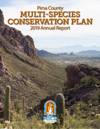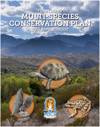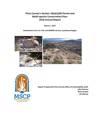The MSCP - part of Pima County's Sonoran Desert Conservation Plan - makes a streamlined ESA process possible thru a commitment to protect, manage, monitor and report on important habitats, landscapes and species in order to mitigate/offset impacts in other areas.
Some details from the MSCP FAQs (retrieved 4/25/2019):
As new development occurs some species listed in the Endangered Species Act will be impacted. Such impacts, whether they occur intentionally or unintentionally, may be illegal unless the U.S. Fish and Wildlife Service (Service) approves a plan to mitigate for these impacts. This approval requires the Service to issue a ‘Section 10 permit’, so called for its reference to the section of the Endangered Species Act.
Since 1999, Pima County and Pima County Flood Control District has been acquiring open space or flood prone lands through voter-approved bond programs. Many of these lands will be used to fulfill mitigation land requirements of the Section 10 permit. ... The amount of open space land the County currently has, along with some of the flood prone land owned by the District, appears to be sufficient to provide mitigation for at least the first 20 years of the Section 10 permit.

About the image above:
5.3 Gila Topminnow for Vector Control
In 2016, County staff began discussions with the USFWS and the Arizona Game and Fish Department (AZGFD) to use native fish for vector control, as outlined in section 3.4.1.2.1 of the MSCP. As a result, five “green pools” or cisterns were stocked with Gila topminnow by the Health Department during 2017 (Figure 5, Appendix 3).
Pima County is the first Health Department in the state to use the Gila topminnow, and another county has expressed interest in utilizing the species as a tool for reducing the threat of mosquito-borne diseases. Assistance for the County program start-up came from the Phoenix Zoo, Arizona State University, and Bureau of Reclamation, as well as USFWS and AZGFD.
Placement of topminnow is subject to numerous requirements intended to ensure the topminnow do not inadvertently escape from the swimming pools and other contained, mosquito-ridden water bodies where Health Department staff may place them. For example, topminnow are not placed in washes or locations that may overflow into washes. There is no obligation for the owner who accepts fish from the Health Department to feed or maintain the fish, and take is reported when the animals are stocked at the site (Appendix 3).
Source: 2017 MSCP Annual Report Pdf and 2017 MSCP Appendices Pdf from the Multi-species Conservation Plan - Pima County.
Previous Year:


